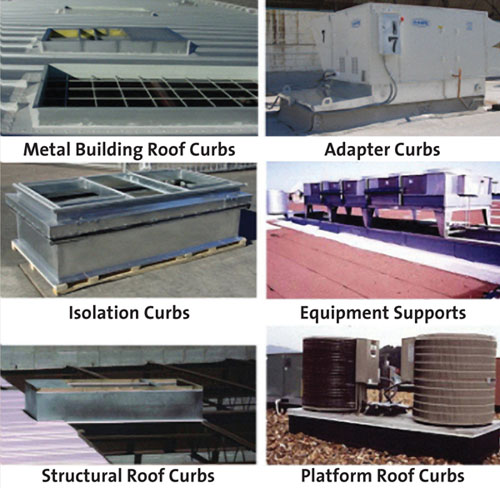Roofing Strategies Reach New Heights: Sustainable Options for a Key Building Element
Preventing Leaky Roofs |
When it comes to roofing, selecting a sustainable strategy means designing a roof that will endure with minimal repair - and that means a watertight roof. Roofs can be sabotaged by leaks which can result from many factors including accumulated water or snow, punctures caused by flying debris, deterioration of the roofing material, and faults in the flashing around chimneys, vents, fans and the skylights. For those roofs that do need flashings and curbs, another cause of leaky roofs are improperly manufactured or installed roof curbs, the square metal boxes that surround penetrations to assure that the roof remains watertight. A big question here is who is responsible for roof curbs. Equipment manufacturers do fabricate roof curbs, but they don't design them with leak prevention in mind. They concentrate on supporting the unit they manufacture, and often they don't have the knowledge of proper roofing practices or the requirements of a particular roof. Usually, their standard roof curbs do not mate with the many kinds of roof deck situations being specified. Improper curb design for rooftop HVAC units, exhaust fans and other equipment can all mean roof leaks down the line. Leaving the job of building curbs to on-the-job contractors is also problematic. Contractors typically build curbs to roof-opening size, not to the size of the actual equipment . Many times scrap material available on the job site is used to build the curbs. When this happens, the equipment being mounted on the job-built curb can be larger than the opening, leaving a gap between curb and equipment cap - and an opportunity for water to seep in. Using tar to meld it all together can result in further problems down the line as tar can crack in winter and melt in summer, opening the way for leakage. In many instances, custom prefabricated roof curbs offer a more effective alternative. These curbs are fabricated to fit the exact units selected after bid, rather than an approximate roof-opening size plugged in during design. They're also designed for the specific type of roofing condition involved, including standing seam metal roofs, membrane roofing, different roof slopes and difficult roofing conditions. Prefabricated curbs are installed before the roofer is required and therefore become part of the roofing system. If they are mounted properly beneath the insulation, most roof leaks will be eliminated - they should never be installed on top of the roofing or insulation on new or existing construction. Prefabricated curbs are also available with raised cants to allow the roofer's insulation to mate, that is, the roof cant starts at the finished roof and not below the insulation thickness. Prefabricated curbs are also available in all sizes and custom configurations.
Proper Specification Beyond that, choosing one manufacturer to provide curbs for all roof penetrations, including expansion joints, HVAC, fans, skylights, etc., offers the advantages of cost effectiveness and a single responsible source to ensure roof curbs are on site when the steel is delivered. "Asking a mechanical contractor to be responsible for a watertight roof, and providing curbs for work other than HVAC work is folly, says Robert Banicki, President of Roof Products, Inc. "With proper specification, you guarantee all roof curbs to be designed and coordinated for the project at hand." All roof curbs should be a minimum of 8 inches above the finished roof and should be welded or sheet-screwed to a metal, wood, or tectum deck or to the structural steel. On a concrete roof deck, ram setting, or power-charged screw, is the most popular. The curbs are insulated with 1.5-inch, 3-pound density of rigid fiberglass insulation to reduce condensation. If the insulation is not applied at the factory, the roofer must cut in insulation at the job, which is difficult and more expensive, especially if curbs are canted and pitched-and there is little margin for error. If the insulation is installed on the outside instead of within the curb, condensation occurs and, later, dripping water into the building. Even though mechanical contractors throughout the United States still use wood timbers for roof-mounted condensing units, gas pipes, and rooftop units, wood may not the best material to use. Any wood member larger than 2 x 4 will start to warp, especially when used as an expansion joint. When cracks form, water seeps in. Wood installed on top of insulation also causes movement of gas pipes, scraping away roofing stones and eventually digging into the insulation. The result is clear-water will find its way into the building. Easing Retrofits |











